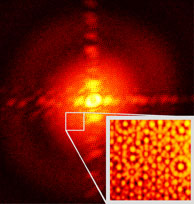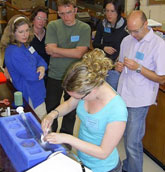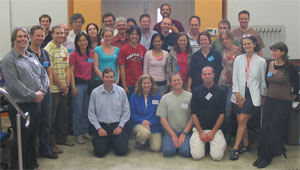

Contents of this Issue:
1. Science Highlight —
Five Images for the Price of One: Using X-ray Holography
for Simultaneous Imaging
(contact: W.F. Schlotter, wschlott@slac.stanford.edu)
 |
||
Holographic references were defined by five nanoscale holes, and the test sample was a 1-micron tall block letter F. Its diffraction pattern was recorded as a hologram on an x-ray sensitive digital camera. The researchers produced a recognizable composite image of the sample after detecting only 2500 x-ray photons. The group found that compiling holographic images from multiple reference sources improves image quality by minimizing noise from imaging systems.
The team of Stanford researchers and their collaborators conducted the proof-of-principle experiment at SSRL beam line 5-2.
To learn more about this research see the full scientific highlight at:
http://www-ssrl.slac.stanford.edu/research/highlights_archive/ft-holography.html
2. Science Highlight —
Using Microorganisms to Understand Hydrogen Catalysis
(contact:
R.K. Szilagyi, szilagyi@montana.edu)
 | |
|
| |
Using sulfur K-edge x-ray absorption spectroscopy data from SSRL's beam line 6-2, the researchers probed the nature and the strength of the chemical interaction between the 4Fe- and the 2Fe-containing subclusters of the active site H-cluster. By comparing the spectra of each subcluster and the biomimetic H-cluster framework, the team found evidence for considerable electron delocalization between the subclusters, suggesting that the H-cluster is an electronically inseparable [6Fe-6S] cluster. Computer modeling on the separate and combined subclusters also show this delocalization by the presence of molecular orbitals that span the entire 6Fe-framework. Thus, the catalytic activity is determined by both subclusters together, not just the [2Fe-2S] subcluster that has been the focus of much past research.
To learn more about this research see the full scientific highlight at:
http://www-ssrl.slac.stanford.edu/research/highlights_archive/FeFe.html
3. Science Highlight —
Ultrafast Bond Softening in Bismuth - a Femto-second Pump-probe SPPS Study
(contact:
D.M. Fritz, dmfritz@slac.stanford.edu)
 | |
| One hundred consecutive electro-optic signals. | |
The crystal distortion oscillates for a brief time after the laser excites it - only a few picoseconds, but long enough to be easily resolved by the 160 femtosecond x-rays from SPPS. Fritz and his colleagues used this motion to measure not only the distortion, but the size and character of the binding force itself, over a range of distortions. They conclude that the presence of conduction electrons weakens the crystal bonds in a way that had been predicted but never before measured directly.
To learn more about this research see the full scientific
highlight at:
http://www-ssrl.slac.stanford.edu/research/highlights_archive/spps07.html
4. XAS Course for Structural Molecular
Biology Applications — March 13-16
(contact:
S. DeBeer George, serena@slac.stanford.edu)
 |
|
5. SSRL Advisory Committees Convene in February
(contact:
J. Stöhr, stohr@slac.stanford.edu)
The SSRL Scientific Advisory Committee (SAC) convened on February 15-16 to
review and advise management on current and proposed programs at SSRL. The
meeting began with an update by SSRL Director Jo Stöhr on projects reviewed at
the July 2006 SAC meeting, plans for staffing, and a discussion on SSRL's
strategic planning process. Several representatives from the SSRL Users'
Organization participated in a discussion aimed at finding ways to solicit
scientific ideas from users and further engaging them in the process of
prioritizing initiatives. Updates were provided on the Structural Molecular
Biology Program, including presentations on RNA polymerase (Roger Kornberg),
Macromolecular crystallography developments (Mike Soltis), Non-crystalline
scattering studies in structural biology at SSRL - Instrument developments and
scientific applications (Hirotsugu Tsuruta), and Biological XAS processes and
scientific highlights (Britt Hedman). Uwe Bergmann and other members of the
SSRL Recruitment and Retention Task Force also met with the SAC to discuss
staff scientist advancement.
http://www-ssrl.slac.stanford.edu/sac/index.php
Following the SAC on February 16, meetings were held by the SSRL Structural
Molecular Biology Advisory Committee and the SSRL Proposal Review Panel. In
their executive session, the PRP determined ratings based on the peer reviews
received for new proposals and program proposal extensions submitted during
this last call for proposals.
http://www-ssrl.slac.stanford.edu/prp.html
6. John Zachara among Eight DOE Lawrence Award
Winners
|
| |
John Zachara, who serves on the SSRL Proposal Review Panel and SSRL Scientific Advisory Committee, is an environmental geochemist from the Pacific Northwest National Laboratory in Richland, Washington. Zachara has made seminal scientific contributions to understanding geochemical and microbiologic factors that are critical to the fate and transport of metals and radionuclides in the environment. His studies of how toxic metals travel in the subsurface environment of the Department of Energy Hanford site are helping provide science-based environmental cleanup solutions with broad applications. Congratulations to John and the other Lawrence Award recipients. http://www.doe.gov/news/4769.htm
7.
SSRL Macromolecular Crystallography Remote Data Collection Workshop Held in
Australia
 | |
 | |
| Workshop participants [larger view] |
8.
X-ray/VUV Beam Time Requests due by March 5
X-ray/VUV Beam time requests for the final scheduling period in our FY2007 (May-August 6) are due by Monday, March 5.
http://www-ssrl.slac.stanford.edu/users/user_admin/xray_btrf.html
http://www-ssrl.slac.stanford.edu/users/user_admin/vuv_btrf.html
9.
Photon Science Job Opportunities
__________________________________________________________________________
SSRL Headlines is published electronically monthly to inform SSRL users, sponsors and other interested people about happenings at SSRL. SSRL is a national synchrotron user facility operated by Stanford University for the U.S. Department of Energy Office of Basic Energy Sciences. Additional support for the structural biology program is provided by the DOE Office of Biological and Environmental Research, the NIH National Center for Research Resources and the NIH Institute for General Medical Sciences. Additional information about SSRL and its operation and schedules is available from the SSRL WWW site.
__________________________________________________________________________
To leave the SSRL-HEADLINES distribution, send email as shown below:
To: LISTSERV@SSRL.SLAC.STANFORD.EDU Subject: (blank, or anything you like)
The message body should read
SIGNOFF SSRL-HEADLINES
That's all it takes. (If we have an old email address for you that is forwarded to your current address, the system may not recognize who should be unsubscribed. In that case please write to ssrl-headlines-request@ssrl.slac.stanford.edu and we'll try to figure out who you are so that you can be unsubscribed.)
If a colleague would like to subscribe to the list, he or she should send To: LISTSERV@SSRL.SLAC.STANFORD.EDU and use the message body
SUBSCRIBE SSRL-HEADLINES
|
SSRL Welcome
Page | Research
Highlights | Beam Lines | Accel
Physics
User Admin | News & Events | Safety Office |